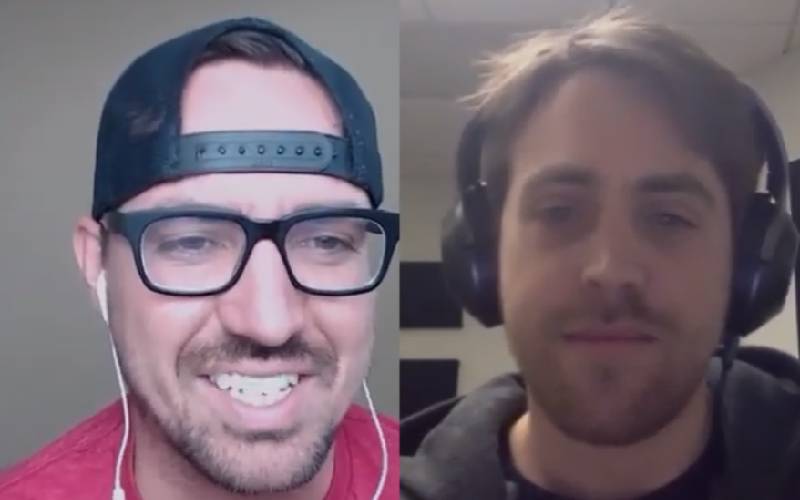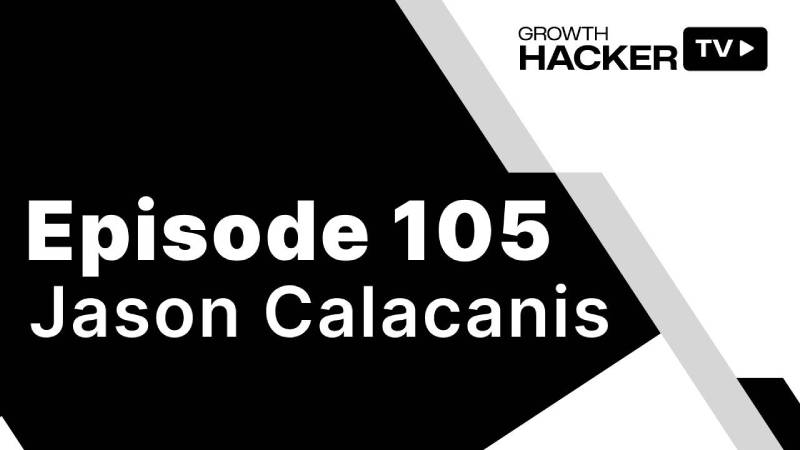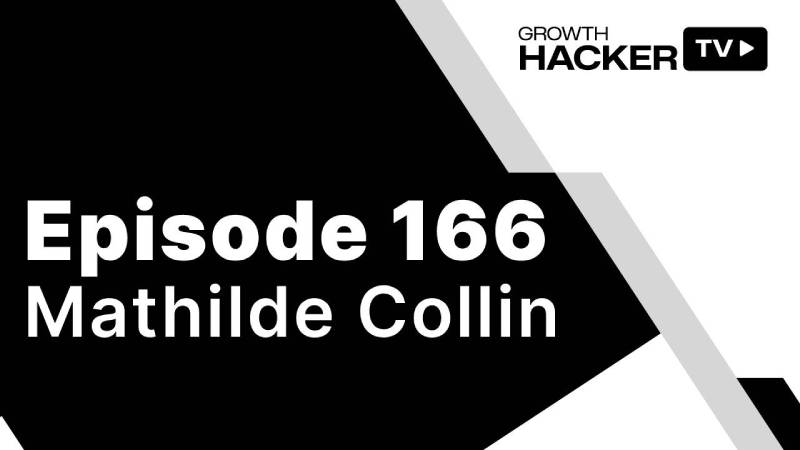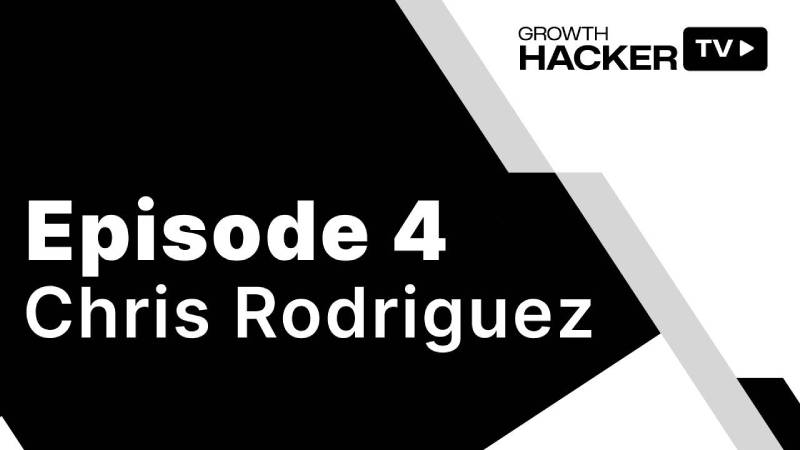Data is the new oil. Unfortunately, data science is not something easy to learn. In this episode, I spoke with Martijn, CoFounder of DataCamp, the best place to become an expert at R, Python and data science online. DataCamp already has more than 1,000,000 learners and it was not an easy thing to achieve. We can all learn from his story.
TOPIC MARTIJN THEUWISSEN COVERS
→ He is the co-founder of DataCamp
→ DataCamp already has more than 1,000,000 learners
→ He is dedicated to as online interactive learning platform for data science
→ They have over 700,000 people on the platform taking courses and it’s a freemium model
→ They grow from zero to roughly 4 million annual recurring revenue for the last two years
→ Data science is hype of course
→ The key metric is smartly recurring revenue and revenue in general
→ And a whole lot more
LINKS & RESOURCES
→ Datacamp
WATCH THE INTERVIEW

READ THE TRANSCRIPTION
Bronson: Welcome to another episode of Growth Hacker TV. I’m Bronson Taylor and today I have Martin to reason with us. Now, I didn’t ask you to pronounce your last name. Is that actually correct?
Martijn: That’s that’s kind of correct.
Bronson: That’s kind of correct. That was the right way to say it.
Martijn: At Davidson, actually.
Bronson: Okay. All right.
Martijn: So it’s notable.
Bronson: Yeah, it is unpronounceable. That’s right. So, Martin, you are the co-founder and CEO of Data Camp. Right. Okay. And so tell us about data camp. How did you get started? What is it? I mean, data is all the rage. What is data camp?
Martijn: Yeah. So I’m actually responsible for all the marketing. So one of the other co-founders is a CEO, but just that doesn’t matter. So I’m so dedicated as online interactive learning platform for data science. So we teach people open source technology so that they can do their own analysis. It’s fully online, it’s interactive, which means that you get instant feedback based on the type of mistakes you make. So I guess many of the people are familiar with something like Codecademy or something to learn about Solomon. So Burdette for data science, because the approach is a bit similar, you type in code and you get a certain output. Now instead of a web page, you get a predictive model or a data visualization or something that you can apply the same didactic goal techniques. So that that’s what we do. We have over 700,000 people on the platform taking courses and it’s a freemium model. So the typical subscription model, you can take some courses for free. You can explore a little bit and then if you want, have access to everything, you just take the full subscription.
Bronson: Is interactive a much better way to learn than just consuming videos or reading PDFs. Is there science behind this actually working better?
Martijn: Yeah. So there are the best science there is. And looking at the engagement figures and the completion figures, because what it’s what is important, if you take an online course, it’s like, okay, how many people actually get to the end of the course? So if you compare completion figures, the average massive open online course, like what you can follow on Coursera editions are like the typical video exercises. That’s like below 10%. While at an interactive platform like, like that, again you see between 50 and 70% completion, which is of course a lot more.
Bronson: Yeah, it seems like it almost turns into kind of like a video game. It’s like it’s like you go into the next level, you’re unlocking the next thing. It’s a new idea. A new. Is that right?
Martijn: Yeah. Yeah. The best comparison I’ve ever heard was. So was it comparison with movies? So when. When movies started, like 1800s and 1800s, they were just filming, like, theater pieces. So it was like a theater and they weren’t really using the medium itself. And now today we have walking dinosaurs and things like that. Yeah. So it’s his own medium and it’s the same is happening with education. Like the first massive open online courses are just filmed the classroom. So it’s like the theater, they film the classroom, they put it online and now they’re using all this technology you have like these great companies, like I could go to school 3 hours as well, and they are doing all of this in an interactive way and rethinking how you can or you can educate people.
Bronson: And it seems like a lot of technology, you know, slanted subjects are becoming interactive, like you mentioned, you know, tree house and code academy and, you know, you guys with they camp. Do you think it’s going to, you know, go mainstream? Are we going to start learning other subjects that are not tech heavy would through an interactive way eventually.
Martijn: Yeah, I think so. I think a good example is do a duolingo to learn languages. So that’s that same that same approach. I recently read about a startup, can’t remember the name. It’s doing it for drawing. So, like, with a new big Microsoft, I can’t remember a name. Like, you can actually show people how to how to do drawing in an interactive way. So I do think it’s going to be become more and more mainstream to learn in that way.
Bronson: Yeah, it seems like the future. I mean, recording a classroom like your analogy is really good that it’s basically recording theater and you know, they always say that every new technology needs to find its own content. You know, MTV needed music videos, you know, Twitter needed, you know, the short, you know, pithy sentence. So it seems like education really is about interactive online, not just watching, you know, MP for. So let me ask you this. You guys are in Belgium and you’ve come to the US. Why is that? It seems like you can run this business for Belgium just fine.
Martijn: Yeah. Yeah. So there are a couple of reasons. So one is the the market in the US is way bigger. It’s it’s more open to do the type of education that we want to provide. So for example, in Belgium, education is very cheap while in the U.S. it’s it’s way more expensive to go to University of College or there is more open. To alternatives from from a business perspective. Like the good teachers, good instructors, many of them are based in the U.S. So we work with external instructors. So that helps us to to reach them. And then in terms of like investment. So we’re Belgium is as a way different country to get investments. I’d imagine so. Yeah, it’s trade. Traditional Europe, European country. So okay, by coming to the to U.S., we open up that opportunity. But we actually still have an office in Belgium. The majority of the engineering team is is based.
Bronson: Yeah. Makes sense. So you guys have grown quite a bit. You said you have several thousand people registered using the software on your freemium model. You know, it seems like you guys have grown by going community to community. Talk me through what your growth was and how you really focused on specific communities to do that.
Martijn: Yeah, so it all sort of like so we’re big fans of the books 0 to 1 Peter to.
Bronson: Everyone is.
Martijn: One point. So but one of the things that he mentions in the book, it’s like, okay, it’s very smart to have like a monopoly, monopoly in one area and then slowly expand into other areas. So when we started with the first, so government first was actually not learned data science, but learn are and are is a programing language that’s heavily used in statistics. And so we started with, okay, building a new stair and building our interactive platform tailored to learning. Ah and what was nice was that at the same time that, that we started focusing on are our, is getting more and more adoption in industry. So it grew out of academic, so we get more and more industry adoption. So we like nicely right that way. So now today we have a very strong name for online learning in the art space. And then we started expanding into the next language, which was Brighton. So then fighting for data science was a focus and next month we’re going to release sequel. So we tried to establish a name and a community and now we go to the next community and that’s how we try to grow from within that community rather than general education.
Bronson: Yeah. And what did you actually do to grow? Like where did you actually find the customers? Where you going into, you know, chat rooms or they’re talking about our on subreddits or like, what do you do and actually get them to know you guys exist.
Martijn: Yeah. So and in the beginning, we, we were very active in the community itself. So we attended like conferences, we gave talks. And also our model is that we have external instructors in front of the camera. So we, we try to work with the best instructors in the fields, which also often means that they have a very strong brand value in that field. So we leveraged their brand to give validation to our model as well as to like create word of mouth and send people towards our platform. And then we collaborated with some other professors that already had online courses. So we said like, Hey, why don’t you use data like not as your main platform, but just to f interactive labs. So we were like the labs in the classroom app and like they’ve done a lot of traffic and that’s how we start building our name actually.
Bronson: Now it makes sense. So where are you guys at right now in terms of revenue, if you don’t mind sharing?
Martijn: No, no. So we grow in the last last two years when we started with with a subscription model, before we had like an individual like you could pay for an individual course. We grow to zero to roughly 4 million annual recurring revenue last two years.
Bronson: Well, that’s incredible. Good job. So taught him about data science in general. It seems like it’s becoming more and more popular, also becoming more and more important. You know, studios are actually, you know, starting to think, I need the data. I need to, you know, be data driven, data informed. Do you see data science as, you know, a fad that’s going to go away soon? Or is this just the beginning of something very large for the future?
Martijn: Yeah. So our idea on that is that, well, data science is a hype, of course. Now, like it’s it’s a lot of a lot of studies going around on that particular topic. And but the underlying stream is that everyone is becoming more and more data savvy. So what you see is that while previously the data was only accessible to the IT department, now like the marketing department to finance department, the like certain parts of the engineering departments, they all get access to their own data and they all want to start doing analysis on it. So if you like, take de groat marketeer so you get. You can get very interesting data from your Facebook ads, pull it in into our Python match with your AB testing data. So you’re not a full time data scientist, but as part of your job, you need to understand how to handle data. And that’s totally different. Like from three or four years ago.
Bronson: Yeah. And it seems like, you know, you guys are really focused on the people that want to get in there and do their own queries, find their own data, make their own connections, find correlations. It’s almost a step above. Let me just plug in JavaScript from KISSmetrics. Let me just plug in JavaScript from Mixpanel and then play with it in there. This is for someone who needs a little more power, is that right? They want to.
Martijn: Yeah, indeed. I want to get I want to create an edge by getting more insights.
Bronson: Yeah. And do you think that really opens up a lot of opportunity for them, or is it just fun to do it yourself? Like, does it actually give them more insight? You know what I mean?
Martijn: Yeah, I know. It’s it’s definitely more fun in my opinion. Now, to give you a specific example. So when we get email data, so you have your email data to to MailChimp or Mandrill or something, and you can see the open rates and electro rates. Now if you want to match that, but like your user behavior data, for example, like what particular courses did they took, how far did they went into the process? Did they actually completed it? So then you’re going to match that with like data from your internal database events data. So if you want to start connecting flows, then being able to do it yourself, you can get way more tailored and every product has its own different mechanism dynamism that, that can be captured by like a generic tool.
Bronson: Yeah. Now that’s a good point. And we run into that all the time where there’s just no central place with all the data, you have silos. And as much as I wish the silos were gone, I wish I could have all the data in one place with this great user interface to, you know, make all the connections I want. I don’t think it’s ever going to happen because there’s always new things coming out. There’s always old things dying. We’re always going have to live with data silos, aren’t we?
Martijn: Yeah. Yeah, indeed. And but most provide an API to connect to it. So, so.
Bronson: You know, ah Python. You can use the APIs that actually make it do what you want.
Martijn: Mm hmm. Indeed.
Bronson: Now, it makes a lot of sense. I mean, it definitely is. I agree. I think it’s a a level more of power and of fun. So one of things you guys have done is you’re in the process of building out a growth team. Is that right?
Martijn: Yeah, indeed.
Bronson: So talk me through that. How did you know you were ready to build out a growth team and how are you thinking about it? Are you dividing it out based on roles this person before focus on this kind of marketing or is it more all in it together with project? How are you thinking about the growth team itself?
Martijn: Yeah, yeah. So we, we, we started with it. So we, I once read this blog post, I think it was from Sean Ellis like where he said like you have people in the growth team that like in the beginning you have people that are hustlers and they work their way through to get that initial traction. But after that, you’re in a phase that you need more structure, like you need to start approaching growth and a structure. Running test in a in a in a decent way. So I’m definitely like that first person. Like the second person isn’t isn’t this isn’t my strong suit and but so when you start growing and all of a sudden you start realizing like I’m spending my time more and more on like small stuff, like answering certain emails, always doing the same thing again. That’s when you, when you can’t keep up. Like growing to grow in users. That’s when you start to feel like, okay, we need to structure this more and then we need to approach it in a better way. We need to better our responsibilities to align people. So that realization came like roughly six, nine, six, nine months ago. And then questions arise like, okay, do we put like an engineering person within the team or not? And we test it with that. We eventually decided that we want to have like engineering within the engineering team and we are an internal client to the engineering team, but I’ve seen different models. So all those kind of things that we that we started to figure out and the way that we set it up today is there’s one team that’s doing the acquisition. So it’s purely an acquisition team and our one team that’s actually responsible for everything that has to do with revenue, customer success, understanding how to extract more value from existing customers. So that’s how we made the split. And the reason is that there is like, you know, seeing a graph going up and use it, it’s always fun. So you’re like getting more and more into that and you lift the customer success aspect to the optimization like come second. And by splitting it up, we also hope to do revenue optimizations. They’re getting more people in your. Options versus monthly subscriptions. So that’s how we.
Bronson: Know it makes a lot of sense. Are you guys concerned? I’ve read about this before where when you break things out based on the funnel that you can have a group that’s worried about customer acquisition. And if they don’t think about it in terms of the entire funnel, they go out and get a lot of really crappy users so they can get their stats up into the right. And then the customer success people, they get their stats up to the right, but as a funnel as a whole, it doesn’t work. Do you guys like collaborate and really think about the big picture so that you don’t just have individual metrics that you’re achieving, even though the whole is broken, if that makes sense?
Martijn: Yeah. Yeah, that’s and that’s one of the things that we ask ourselves as well. And so the way we fix that is like one, having communication lines between the lead of the acquisition team and the lead of the revenue team, the customer success team, and at the same time having a shared metric. So our key metric is smartly recurring revenue and revenue in general. So dosed both photos teams share the metrics on that metric goes up, although maybe acquisition isn’t going as high as expected. Okay. Then there’s still an achievement.
Bronson: Yeah. No, it makes sense. I think it just is about communication. But I was just wondering what you guys thought with that. And so you guys have traditionally been B2C, but it seems like you’re you’ve made a switch to become B2B. Tell me about that a little bit.
Martijn: Yeah. So we if you look at our user base of 700,000 people, 70% of them are working professionals. So they are working in technology, marketing, health care, etc., and they’re also working within teams that want to become more data savvy. So we started getting requests like, okay, is it possible to, to have started to camp in a more of an enterprise setting where we can see how my colleagues are making progress, how they’re doing things like create learning, that’s like what courses to take next. And that’s when we realized like, okay, we can offer this as at an enterprise level or within within organizations. And so we slowly started to make that, that transition and building that out actually as our second revenue channel. So today it’s around 15% of our revenue comes from from these these group sales, as we call them. And the way that we achieve growth there is by going back to that initial point and understanding, there are people in our current user base that actually want to know about, hey, do you have do it again for the enterprise setting? So our our entire B2C customer base is actually a huge generator for our B2B offering.
Bronson: It sounds a lot like Dropbox. You know, they had a lot of consumers, the consumers pulled it into the enterprise and the enterprise solution.
Martijn: Yeah. Yeah. And so that’s it doesn’t need to be hard.
Bronson: No, it’s also I mean, that’s the way to do it. Absolutely. Well, you know, Martin, this has been a great interview. Let me ask you to ask questions. This is the two questions I always end on. One is, what are you doing right after this interview is over, no matter how boring or how awesome it is?
Martijn: Okay. So actually my next my next thing is getting lunch after after that. So I have just hired a new person. So we’re going to go over the different goals that person has he made a map of to the different competitors in the space. How does he. It looks like. So that’s a great onboarding experience, at least I hope so, that we know that people understand the space. So I’m going to go over it with him and see where I can I can add value.
Bronson: Yeah, that’s awesome. All right. Last question. What’s the best advice you have for any startup that’s trying to grow?
Martijn: It’s all about two people start building a brand or something for recruiting purposes. Like if you do stuff, write about it, make it, make it public. Because once you start recruiting, then you’ll have so much value out of that.
Bronson: Yeah, that’s awesome. Well, that’s great advice to end on. It is all about the people. Thank you again for coming on growth out of TV.
Martijn: No problem. Thanks a lot. It was a great talk.
Ready To Grow Your Startup?
Get the strategies, motivation, and in-depth interview with all the details every week!
Popular Blog Posts




